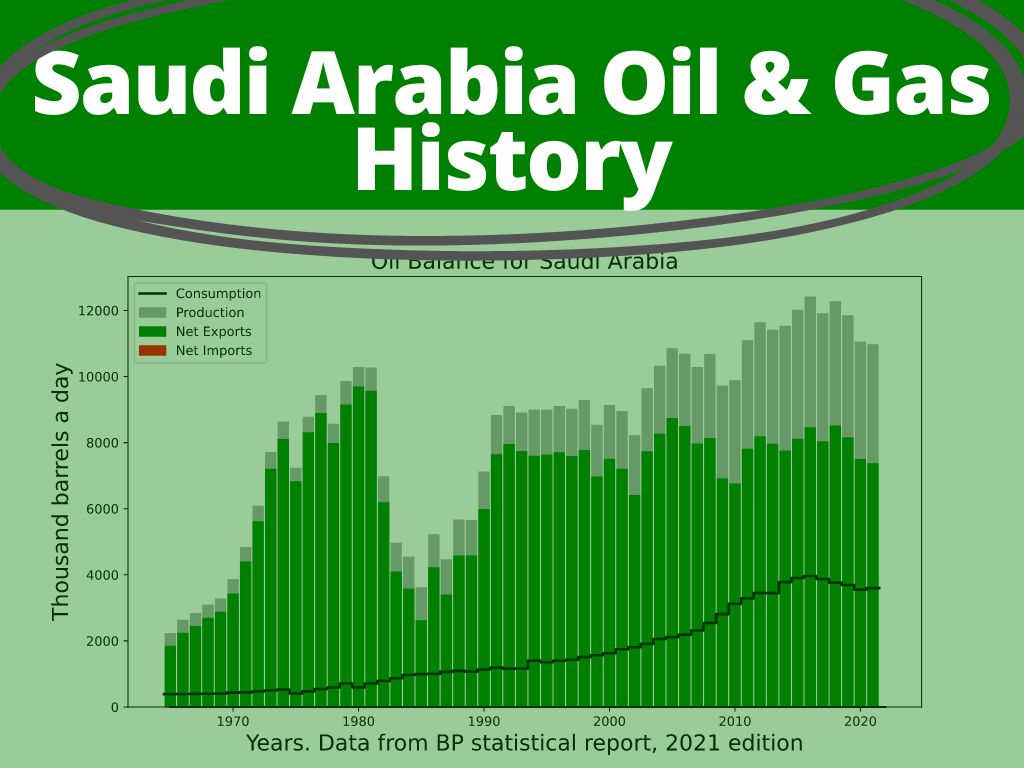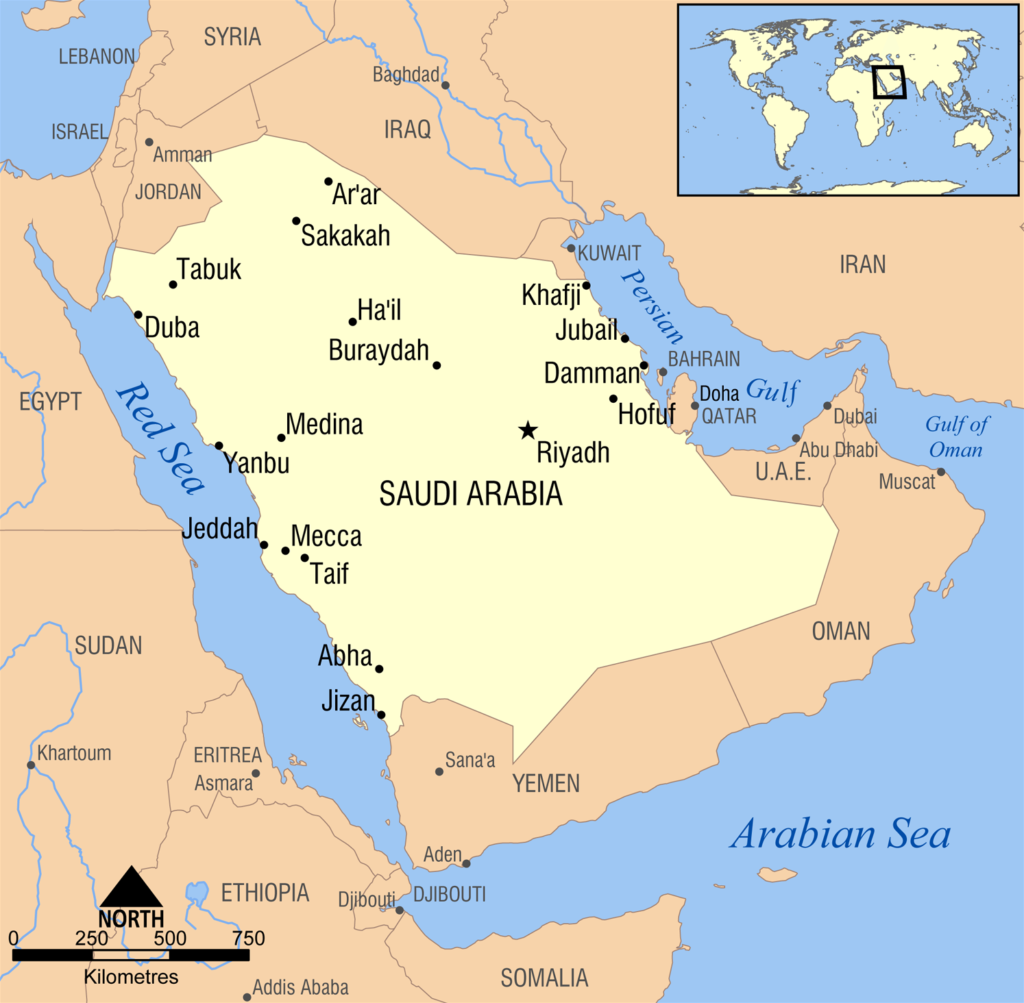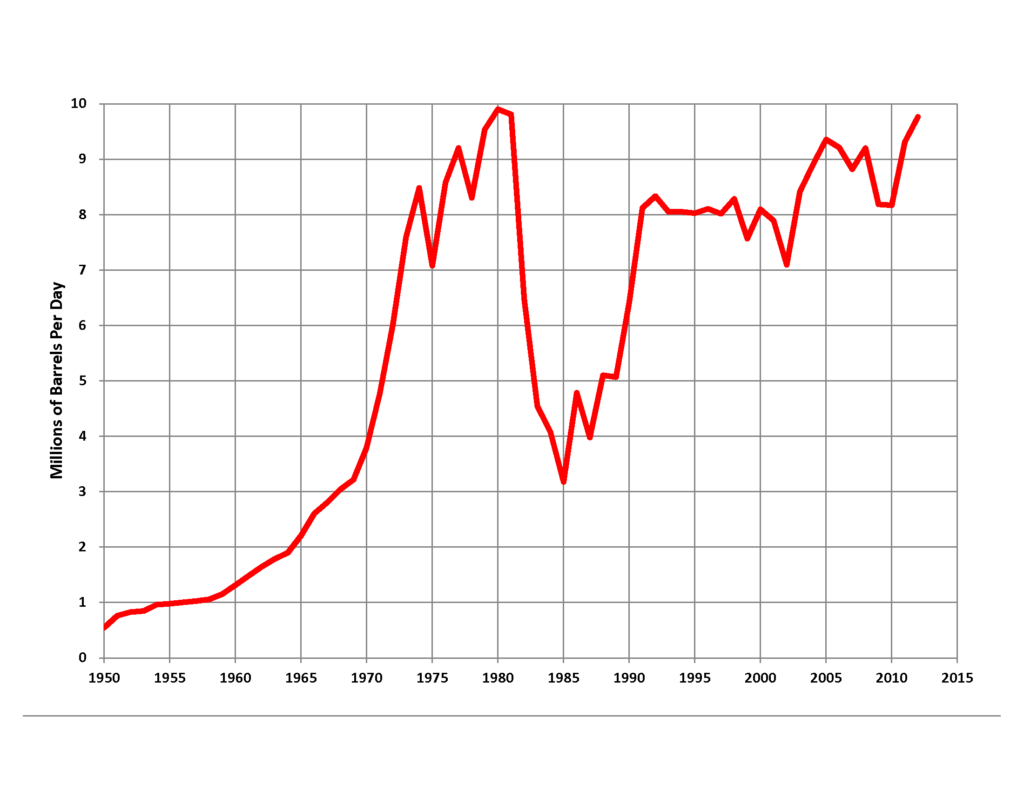Background of Saudi Arabia

Saudi, located in the Middle East, is known for being the largest oil producer in the world. Saudi Arabia oil-rich history began in the early 20th century when American geologists discovered vast oil reserves in the region. In 1933, the Saudi government approved a concession agreement with ARAMCO, a subsidiary of Standard Oil Company of California. This agreement allowed ARAMCO to explore and exploit oil fields in the Eastern Province of SA.
Under the leadership of King Ibn Saud, the country experienced rapid economic growth fueled by oil revenues. Over the years, Saudi Arabia has remained a significant player in the global energy sector, heavily reliant on oil production. Saudi Aramco is the world’s largest oil reserves holder and most profitable company. Saudi Arabia’s large-scale oil production has contributed to its government revenues and significantly shaped the global oil market.

Overview of Oil History in Saudi Arabia
Saudi Arabia is widely known as one of the largest and most influential players in the global oil industry. Oil was discovered in 1938 by American geologists. Aramco was created by the Saudi government and Standard Oil of California (now Chevron) after a discovery.
Over the years, Saudi Arabia’s oil industry has witnessed significant growth and development. By the In the 70s, it was the top oil producer and exporter due to rich reserves and increased output. The country’s oil industry has driven its economy and shaped its political landscape.

The Saudi Arabian oil industry has reached remarkable heights with critical milestones in its history. After being nationalized in 1980, Saudi Aramco has become the most profitable company in the world. Saudi Aramco’s public offering in 2019 solidified its position as a key player in the energy industry.
Today, Saudi Arabia remains one of the world’s most significant crude oil production and export sources. Its oil industry continues to contribute to government revenues and drive economic growth. It will remain a major player in the oil market due to ongoing investments in exploration, production, and refining.
Early History of Oil Exploration and Production in Saudi Arabia
Saudi Arabia’s early oil exploration and production led to its dominance in the global oil sector. With the discovery of oil in the 1930s, the country embarked on a journey that would shape its destiny. US geologists made a deal with Standard Oil of California regarding the Arabian Peninsula.

Source: Flickr
The region started producing oil, leading to Saudi Aramco’s creation. Saudi Arabia’s oil success can be attributed to key historical events.
Standard Oil of California and the First Wells
Standard Oil of California played a crucial role in the early oil exploration and production history in Saudi Arabia. They authorized Standard Oil to explore and extract oil, creating CASOC.
CASOC sent a team of American geologists to explore the Eastern Province of Saudi Arabia for oil reserves. One of the critical geologists was Max Steineke, who led the efforts to assess the region’s potential. In 1936, Steineke drilled Dammam No. 7, the first commercial oil well in Saudi Arabia.
This discovery marked a turning point in Saudi Arabia’s oil industry and changed the country’s destiny. SA is a major crude oil supplier due to its abundant reserves in the Eastern Province.
ARAMCO was founded in 1944 with Standard Oil of California as the major shareholder after successful exploration by CASOC. ARAMCO later became known as Saudi Aramco and remains a dominant player in the global energy sector.
CASOC and American geologists’ discovery of the initial petroleum source was crucial to Saudi Arabia’s oil industry. The country became prosperous with a strong economy and as a major global oil producer.
American Geologists and the Expansion of Oil Exploration History In Saudi Arabia
After signing the concession agreement with Standard Oil of California Company (SOCAL) in the 1930s, American geologists played a crucial role in the expansion of oil exploration in Saudi Arabia. These geologists arrived in Al-Jubail and conducted extensive geological tests in the area, specifically in the region of Jabal Al-Dhahran.
Their expertise and efforts were instrumental in successfully drilling the Dammam Wells, leading to a significant discovery. Among these wells, Well No. 7 proved to be a game-changer in Saudi Arabia’s oil industry. It marked the first commercial oil well in the country.
The contributions of the American geologists in the drilling of Dammam Wells and the subsequent discovery of oil in Well No. 7 propelled Saudi Arabia into becoming one of the world’s largest producers of crude oil. This discovery transformed the country’s destiny and created the foundation for the oil industry’s growth in Saudi Arabia.
The arrival of American geologists in Al-Jubail and their geological tests in Jabal Al-Dhahran were pivotal moments that laid the groundwork for the thriving oil sector that Saudi Arabia enjoys today.
The Discovery History of Offshore Oil Fields in Saudi Arabia
The discovery of offshore fields in Saudi Arabia marked a significant milestone in oil history. While the Dammam Wells had already proven fruitful in the eastern province, drilling in the Dammam Dome posed several challenges. Several attempts at drilling had yet to be successful, leaving the geologists perplexed.
However, an American geologist named Max Steineke insisted on drilling deeper, believing there was still untapped potential. His determination paid off when 1938 Well No. 7 of the Dammam Dome struck oil. This discovery was a game-changer for Saudi Arabia’s oil industry.
The successful drilling of Well No. 7 opened up offshore exploration and production possibilities in Saudi Arabia. It showcased the vast reserves beneath the Persian Gulf and established Saudi Arabia as one of the largest oil producers globally.
The discovery of offshore fields presented new opportunities and posed new challenges. Extracting oil from underwater reservoirs requires advanced technology and expertise.
Despite these challenges, Saudi Arabia, through its state-owned oil company Saudi Aramco, has been able to harness the potential of offshore fields. Today, the country’s offshore oil fields contribute significantly to its crude oil production capacity and export volumes.
Max Steineke’s dedication led to the discovery of offshore oil fields in Saudi Arabia, revolutionizing the country’s oil industry. Saudi Arabia became a major player in the global energy sector by exploring and producing oil from underwater reservoirs.
History of Aramco In Saudi Arabia Oil & Gas
In the early 1930s, following the discovery of oil in Saudi Arabia, the Arabian government recognized the need to establish a national oil company to manage and exploit the country’s growing hydrocarbon resources. As a result, the Saudi Arabian Oil Company, commonly known as Saudi Aramco, was founded in 1933. Initially, Saudi Aramco operated as a subsidiary of the American oil giant Standard Oil of California (now Chevron). However, as Saudi Arabia sought greater control over its oil resources, it gradually acquired full ownership of Saudi Aramco.
Saudi Aramco is the world’s largest state-owned oil company and owns and operates oil fields in the Kingdom. Their economy relies on exploring, producing, refining, and distributing oil and natural gas liquids. Saudi Aramco’s profitability and success have made it a highly enticing target for foreign investors, with its recent initial public offering attracting substantial interest from domestic and international markets.
From Concession Agreement to Formation of Arabian American Oil Company (Aramco)
Aramco was established in Saudi Arabia after an agreement between the government and foreign oil companies for the concession. The concession agreement was granted to Standard Oil of California (now Chevron) and later extended to other American oil companies. This agreement gave them the exclusive rights to explore and drill for oil in certain areas of Saudi Arabia.
The concession agreement played a crucial role in the establishment of Aramco. The company was formed in 1933 following American geologists’ discovery of oil in commercial quantities. Aramco oversees oil production in Saudi Arabia’s Eastern Province after successful drilling.
Several key events and milestones led to the formation of Aramco. In 1944, four US oil companies partnered with Saudi Arabia’s government. This consortium, known as the Arabian American Oil Company, became the sole owner and operator of the concessions.
The formation of Aramco in Saudi Arabia was a turning point in their oil history. Saudi Aramco’s formation resulted from a significant occurrence, which has now made it one of the biggest oil producers globally.
Foreign oil companies played a crucial role in the formation of Aramco. Through their expertise, technology, and investment, they helped develop SA’s oil industry and transform the nation into one of the world’s largest sources of crude oil production.
The Expansion and Development of Aramco Operations
Saudi Aramco’s growth has established it as a significant player in the oil industry. Aramco has become a worldwide leader in the energy industry. This is because of expanding its operations and refining capacity through strategic partnerships and investments.

One of the critical factors in Aramco’s expansion was its joint ventures with international oil companies. These partnerships allowed Aramco to benefit from the expertise and technology of these companies while expanding its operations. Joint ventures with ExxonMobil and Chevron have helped Aramco increase its production capacity and explore new oil fields.
In addition to joint ventures, Aramco has also focused on expanding its refining capacity. The company operates some of the largest refineries in the world, producing a wide range of refined products. Aramco’s downstream sector involvement secures profitability during crude oil price instability.
Furthermore, Aramco has established subsidiary companies to enhance its operations and diversify its portfolio. These subsidiaries specialize in various sectors, including petrochemicals, mining, and renewable energy. Aramco has expanded its presence beyond crude oil production through these subsidiaries, ensuring its long-term sustainability and success.
In summary, the expansion and development of Aramco operations have solidified its position as a significant player in the oil industry. Aramco is growing in the global energy market through joint ventures, refining capacity expansion, and subsidiary companies.
Role of Chief Geologist in Early Exploration and Production
The role of the Chief Geologist in the early exploration and production of oil in Saudi Arabia was instrumental in the discovery and development of the country’s vast oil reserves. One individual who played a crucial role in this process was the American geologist Max Steineke.
Max Steineke served as the Chief Geologist for the Arabian American Oil Company (ARAMCO) during the 1930s. His expertise in surveying the Arabian peninsula was crucial in identifying potential oil-rich areas for exploration. Steineke’s deep understanding of geological formations and his knowledge of the region’s geology enabled him to recommend areas that should be drilled.
In 1936, Steineke surveyed an area known as Dammam Dome in the eastern province of Saudi Arabia. Despite initial setbacks and the skepticism of some experts, Steineke believed that oil reserves were present beneath the surface. He convinced the Arabian government to continue drilling, and this decision led to the significant oil discovery in Dammam in 1938.
This discovery marked the beginning of commercial oil production in SA, eventually transforming the country into one of the largest oil producers in the world. Max Steineke’s expertise and recommendation to continue drilling played a pivotal role in unlocking the immense oil potential of Saudi Arabia, shaping the nation’s future as a significant player in the global oil industry.
The History Of The Increase in Saudi Arabia Oil Revenues
Saudi Arabia’s vast crude oil reserves have played a significant role in the country’s economic growth and development. They increased oil production and exports to boost revenue. Their economy has benefited from these revenues, allowing the government to invest in infrastructure, education, healthcare, and diversification. This article delves into the factors contributing to the increase in Saudi oil revenues and how it has shaped the nation’s economy.

Emergence as a Major Producer on International Stage
Saudi Arabia has emerged as a significant player in the global oil market, significantly contributing to the industry. The country’s prominence as a significant producer can be attributed to its abundant reserves and the establishment of Saudi Aramco, one of the world’s largest oil companies.
Over the years, Saudi Arabia has rapidly increased its oil production, solidifying its position on the international stage. The Kingdom has been able to harness its vast resources to become the largest oil producer in the Middle East and one of the largest globally.
A key turning point came in the 1930s when American geologists discovered vast oil fields in the Eastern Province of Saudi Arabia. The founding of ARAMCO took place through the signing of a concession agreement between the Arabian government and Standard Oil of California. As a result, Saudi Arabia’s oil industry grew exponentially, leading to substantial investments in infrastructure, exploration, and production capacity.
In 1988, the Arabian government took complete control of ARAMCO and renamed it Saudi Aramco. Since then, the company has played a pivotal role in Saudi Arabia’s economy and the global energy sector. Saudi Aramco has become a profitable subsidiary company, with the Saudi government as its sole owner.
Today, Saudi Arabia’s oil production and export capabilities are crucial for the stability and growth of the global economy. Its vast reserves, combined with the efficient operations of Saudi Aramco, have made the country a reliable and significant supplier in the international oil market, influencing global oil prices and shaping energy policies worldwide.
Becoming the Largest Source of Crude Oil Production in the World
SA has emerged as the world’s largest source of crude oil production. The Kingdom produces a staggering 12,402,761 barrels of oil daily, accounting for approximately 13% of global production.
One critical factor contributing to Saudi Arabia’s dominance in crude oil production is its vast reserves. The country possesses massive oil reserves, estimated at around 266 billion barrels, nearly one-fifth of the global proven reserves. This abundance of resources has allowed Saudi Arabia to sustain its high production levels for many years.
Another crucial element is the low production cost. Saudi Arabia has one of the lowest production costs globally, at just $2.80 per barrel. This low cost allows the country to remain competitive and profitable even during low oil prices, unlike many other oil-producing nations.
Furthermore, they have consistently maintained its production levels over the years. Despite fluctuations in global oil demand and market dynamics, the Kingdom has managed to sustain an annual production equivalent to approximately 1.7% of its proven reserves, ensuring a stable and reliable supply.
In summary, SA has positioned itself as the world’s largest source of crude oil production through its vast reserves, low production costs, and consistent production levels.
Impact on the Middle East and Global Economy
The impact of Saudi Arabia’s oil history on the Middle East and the global economy has been significant. As one of the largest oil producers in the world, they play a crucial role in shaping regional and international oil markets. The country’s vast reserves and consistent production levels have fueled its economic growth and helped stabilize global oil prices.
Additionally, their oil revenues have allowed for significant investments in infrastructure, industries, and social programs within the Kingdom. Moreover, the reliance of many countries on Saudi Arabia’s oil exports has created interdependencies that can have both positive and negative effects on the global economy. Any disruptions or fluctuations in Saudi Arabia’s oil production or its relationships with other oil-producing nations can have far-reaching consequences on energy markets and economic stability worldwide.
Growing Influence Over Global Energy Markets
Saudi Arabia’s growing oil production and status as the world’s largest source of crude oil production have significantly contributed to its growing influence over global energy markets. With its vast reserves and increased production capacity, they play a pivotal role in shaping global oil prices and supply.
The Kingdom’s dominance in crude oil production has given it a considerable advantage in global energy markets, allowing it to control supply levels and influence prices. As a result, Saudi Arabia has become a key player in determining the stability and volatility of the global oil market. Its ability to adjust production levels in response to market conditions has helped stabilize prices and ensure a steady oil flow to meet global demand.
The impact of their oil industry on the Middle East and the global economy has been profound. The country’s oil revenues have enabled it to invest heavily in infrastructure development, diversify its economy, and fund ambitious social and economic reforms. Additionally, the Kingdom’s oil wealth has significantly influenced geopolitics, shaping alliances and diplomatic relationships with major global powers.
Examples of Saudi Arabia’s influence over global energy markets include its participation in production agreements with other major oil-producing nations, such as OPEC and non-OPEC countries. Its decisions regarding oil production levels directly impact global oil prices. Moreover, their ability to swiftly increase production and respond to sudden changes in the market has been crucial in times of supply disruptions or increased demand.
Conclusion
In conclusion, Saudi Arabia’s growing influence over global energy markets results from its position as the largest source of crude oil production. The Kingdom’s ability to control supply and influence prices has significantly impacted the Middle East and the global economy. Its pivotal role in shaping global energy markets has made it a key player in geopolitics and a crucial determinant of oil prices worldwide.